I’ve been staring at a blank page trying to think of where to start on this blog. Or whether I should even write it. I’ve started, erased, and restarted it numerous times. It’s hard to relay what we saw—and the emotion we felt—at Auschwitz.
Let’s start with why we went. We don’t travel because we’re on vacation. We’re not. We travel because we have an insatiable curiosity about the world, its people, their cultures. Travel is far and away a learning experience for us. The impact of seeing where history was made is indescribably different than just reading about it or hearing a lecture on it.
Even still, to visit a place where unspeakable evil was visited upon so many people by their fellow humans wasn’t something we took lightly. We ultimately decided to go because of that element of history and because we were long ago motivated by the most moving bit of oration we’re likely to hear in our lifetimes. It was a prayer uttered by Pope John Paul II when he visited this horrible place. If you’re not religious, it was simply a moving and poetic speech in which a single man begged his creator for forgiveness on behalf of humanity.
Auschwitz, then, is as much a pilgrimage site as it is a historical site.
So why write this blog? The emotions are raw. The images hard to collect and prepare. But the story of Auschwitz is one that must be told. It may be the only way that such despair is not visited upon us again. This philosophy in mind, the Auschwitz museum encourages photography throughout the Auschwitz and Birkenau camps except in one room: the room where literally tons of human hair, collected from tens of thousands of victims bound for the gas chambers and to be used as so much wool, is displayed. It is a simple way to honor the dignity of those human beings.
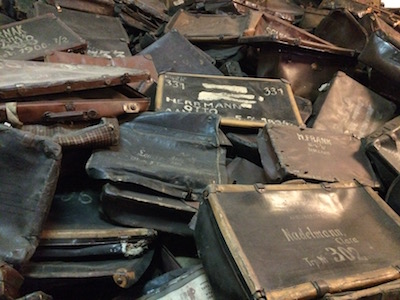

Top: Luggage Left by Arriving Victims. Bottom: Shoes
Auschwitz was a Polish military facility. It was appropriated by the Nazis and converted into a labor camp soon after the German invasion of Poland. Initially it was used for “political prisoners”: Polish military, government leaders at all levels, and academics. Men, at first, were housed in the brick buildings and put to work. As the population of the camp swelled, work became labor. Arriving prisoners were beaten into submission, some to death. Poorly clothed and inadequately fed, many died working in the fields or building new buildings to expand the camp. If a prisoner attempted to escape, he was tortured and executed, and to discourage other attempts, ten of his fellow prisoners were selected and executed at random.
Prison camp became concentration camp. The Nazis held mock trials and executed men, sometimes their entire families, against the “wall of tears”. After mercilessly beating to death an arriving prisoner, one Gestapo officer declared Auschwitz a death camp. Prisoners were lined up in the hospital to receive treatments and were injected with lethal doses of phenol. Meanwhile, other hospital patients endured inhumane experiments before their phenol injection.
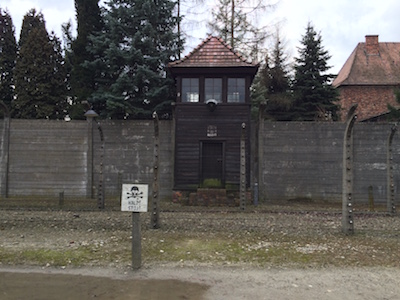
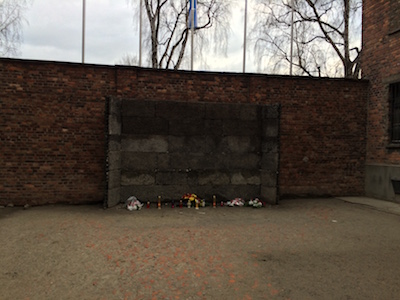
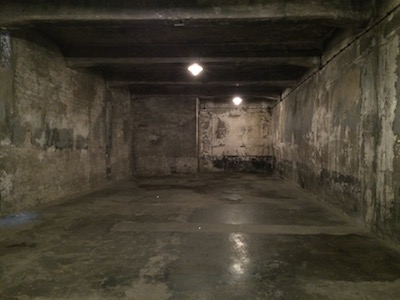
Top: Guard Tower. Middle: Wall of Tears. Bottom: Gas Chamber
The killings, executions, and death at labor grew to such a point that bodies were piled one on the other faster than they could be disposed of. Crematoria were built to dispose of the corpses and allow the death to accelerate. The Nazis experimented with, and perfected, mass killings of Soviet “Bolshevik” prisoners of war using gas chambers. After tens of thousands of Soviet soldiers were disposed of, the Nazis turned their “industry of death” on Jews and Roma and homosexuals and anyone else considered as sub-human. The new and expanding German homeland was to be cleared of the filth, vermin, and undesirables.
The Nazi’s “final solution”, as it was infamously called, planned for the extermination of 11 million Jews from across all of Europe. It is hard to call it a blessing that they only made it halfway there. After the Jews were gone, they planned to exterminate 50 million Slavs. All Czechs, all Poles, all Slovaks, all Serbians, all Bosnians, and all Croats were to be murdered.
Auschwitz was not large enough to accommodate this purpose, so the Nazis constructed nearby Birkenau. Which is to say that Auschwitz prisoners were forced to construct Birkenau, where many would ultimately die. Auschwitz had been the proving ground; Birkenau was designed and built specifically for industrialized murder. Nobody is absolutely certain how many people were killed at Auschwitz-Birkenau; the best scholarly estimates are that 1.1 to 1.3 million people perished here.
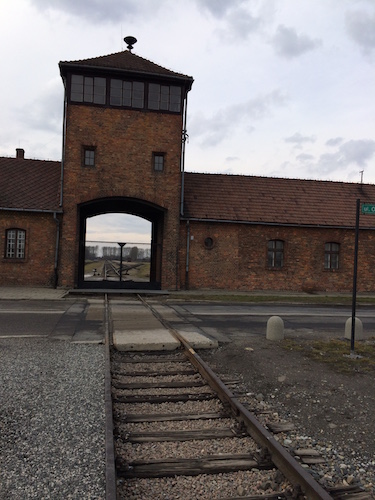

Top: The Entrance to Birkenau. Bottom: The Expanse of Birkenau (only the women’s side of the camp shown)
The tour guide takes us through the gate, under the sign that falsely promises freedom through work. It is intended to hide the true purpose of the camp and prevent an insurrection because of panic. We stand in the yard where prisoners are forced to stand at attention, sometimes naked in freezing weather; if they slump, let alone fall, they are executed—knifed, beaten, shot—on the spot. We walk through the barracks and see the rooms where humans are made to sleep on straw like animals: bunks were a luxury. We see the prison where men are starved to death or suffocated, the courtyard where sham and summary judgment was passed, and the wall where they were executed. Tens of thousands of people were shot at that wall. Prisoners noted that the courtyard often literally flowed red with blood. We walk through the sole remaining gas chamber where hundreds of thousands of innocent people died agonizing deaths, and we are shown the adjacent ovens.
This was Auschwitz. Then we were taken to Birkenau.
I was overcome with emotion. We all need to beg for God’s forgiveness.






